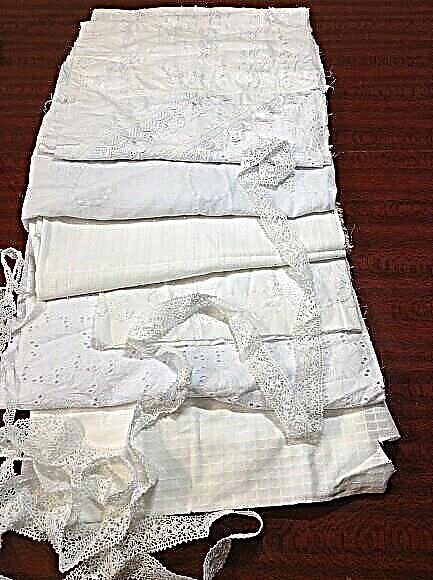Of course, redraw and alter! Beginners are more often faced with a similar situation, but similar incidents happen with experienced seamstresses. We will tell you what can be done and how to fix it.
Even if your sizes completely coincide with the sizes of burda, it happens that after cutting and sweeping parts in the first fitting, you understand that the model is narrow in the chest or hips, or the style is completely not suitable for your style or just don’t like it. A familiar situation, isn't it?
1. Do not panic or give up

Only at first glance, the situation seems hopeless, and the material is hopelessly spoiled. No, this is just the first and obvious reaction to a bad experience. Set aside the product for a while, at least for an hour or a day or two.
2. If the pattern is large, but the model is like

Remove the same pattern, but one size smaller. If necessary, compare your sizes with those of a paper (!) Pattern - waist, hip, chest. If necessary, make the appropriate changes.
Remove the basting, iron the details from the previous cutting and cut them again according to the reduced pattern.
3. If the pattern is small
If the fabric and the width of the allowances allow, try to arrange the details a little. Perhaps this will solve your problem.
Important!
If the product is cut out of a delicate or loose fabric, for example, fine silk, chiffon, muslin or a delicate cambric, this method may not work, since even after marking, these tissues leave traces of perforation from the needle. A short allowance will be difficult to process and they can quickly tear.
How to work with chiffon: we cut, we sew, we look after fabric
If a simple dress, for example, a straight cut, turned out to be narrow in the hips, and allowances do not allow to correct this error, make a tunic with high cuts or a blouse up to the hips. And in the pattern, if you still liked it, make the appropriate changes and boldly sew a dress from another fabric.
On a note:
This error was in the popular model 130 of Burda 1/2010. Many users complained that it was narrow in the hips.
- Special offer

- 1
- 2
- 3
- 4
4. If the pattern is small or large, but did not like the model at all
The best option is to redraw it to another product. This, of course, is not a simple solution, since you have to put up with the obvious loss of footage during subsequent cutting. But at the same time, most of the fabric will be saved and the new thing will still appear in your wardrobe.
Choose a similar model in silhouette, cut and the same amount of detail. Or redraw the product according to a suitable, proven pattern.
Personal experience
- Special offer

- 1
- 2
- 3
- 4
- Best-seller
- Special offer

- 1
- 2
- 3
- 4
The double-breasted dress, model 133 from Burda 11/2012, solution 38, turned out to be too baggy and ridiculous, no hint of the strict elegance of the original. Perhaps it was worth taking the pattern a size smaller, but the reflection in the mirror definitely did not like. Another pattern from the same issue came to the rescue - the popular sheath dress, cut-off at the waist, model 122. The sleeve did not even have to be redrawn. Only the length of the dress was affected, which, in general, was not critical.
- Special offer

- 1
- 2
- 3
- 4
 Trench coat
Trench coat- 1
- 2
- 3
- 4
A trench coat with raglan sleeves, model 103 from Burda 9/2012, solution 38. Perhaps the model was originally conceived this way - from the male shoulder - but in fact I did not want to drown in the resulting volume at all. Changes in size also did not lead to the desired result. An alternative solution was the pattern of a short trench coat, model 134 from Burda 11/2008. The fitted silhouette, the same raglan and the same details radically changed the original idea, but the problem was solved.
- Special offer

- 1
- 2
- 3
- 4
- Special offer

- 1
- 2
- 3
- 4
A very recent experience is a beach sundress, model 107 from Burda 7/2017, solution 38. The bodice was completely out of size. Correct it due to allowances was not possible. Due to the fact that the details of the skirt were cut almost the entire width of the fabric, the panels turned out to be large. They were enough to redraw the sundress on a straight-cut blouse with sleeves, model 102 from Burda 9/2016. Of the "losses", only the length of the product and the sleeve can be noted - they are slightly shorter than in the original. Thus, the silk cut was saved.
Tip: for this model of a sundress, it is best to use heavy, flowing silk and viscose fabrics that are well draped.
5. If the pattern of many small details did not fit
This is perhaps the saddest situation that can happen in sewing practice. Of course, if you made a mistake in the positive direction, then you just need to redraw all the details one size smaller. But if the product turned out to be small, then finding a way out will be much more difficult.
How to sew lace into a single fabric
You can use decorative or lace braid and, due to its width, arrange seams. But if the details of the pattern do not allow such manipulation, you can sew beautiful and useful accessories from them, for example, a flower brooch, a cosmetic bag or a case for glasses. And use larger parts for the composite lining.
Simple and beautiful do-it-yourself cosmetic bag
And one more tip
If when buying fabric you made a mistake in the footage, but noticed this after cutting the details of the product, and there is no way to buy fabric, then the color blocking style will come to the rescue. It does not have to be some kind of contrasting fabric, you can choose the textured material in the same color scheme or find a companion of the same color and quality, but with a printed pattern. There are many options!
Photo: pixabay
In the comments, share your personal experience in correcting cut, wrong size, or “wrong” model errors.



